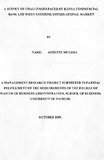| dc.description.abstract | Today, banks are operating internationally in order to reach out to more customers and increase
their profitability. In their quest to venture into the international markets, the banks face different
challenges that could be similar to other banks or that are special to the particular bank. This
study sought to find out which challenges were faced by Kenya Commercial Bank as it expanded
its horizons to the international markets. The bank's major challenges revolved around the macro
environment factors which the bank sought to resolve before entry into these markets. The main
challenges included culture, language, political climate and stability, economic growth of the
country, inflation rate, consumer and investor confidence, population size and distribution, age
distribution, education levels, income levels, efficiency of infrastructure and industrial
productivity. The study used primary data collected from senior managers ofthe bank by way of
a questionnaire. This was the most appropriate method of collecting data as it involved the key
people who make decisions regarding the banks expansion programs.
The study found out that the macro environmental factors were really important in the banks
decision of entering the international markets. The politics of the country determined the nature
of the business environment. Its stability thus determined how safe the bank felt its operations
would be. The tax regime in these countries determined how much the bank would be taxed and
how this reflected on the business. The bank also had to foresee growth in these regions so as to
do business there. Inflation rate also determined how stable the market would be and so does the
exchange rate.
v
Social cultural elements created a major challenge for the bank as it sought to enter these
markets. Population size and distribution affected the location of the branches. Age distribution
affected the decision of which products to promote as some are focused on some age brackets.
Religious affiliations also affected entry especially in Muslim affiliated countries as they do not
have conventional banking. Income levels are a challenge as the bank is targets this money for
deposits .. Education levels created a challenge as it affected the income levels of the banking
population. Technological elements were a key factor. Efficiency of infrastructure determined
how seamlessly the bank operations would flow. The industrial productivity determined if there
was a likely hood of competition and how lucrative the business was. New products and services
of competitors determined how much customers the bank got and their volumes in relation to the
products offered. In conclusion, the project hopes to help assist other local banks who would
wish to do international business on how to minimize the macro economic challenges that they
may encounter. The study also aims to assist the management of the bank to deal with past
problems while moving to other countries | en |

